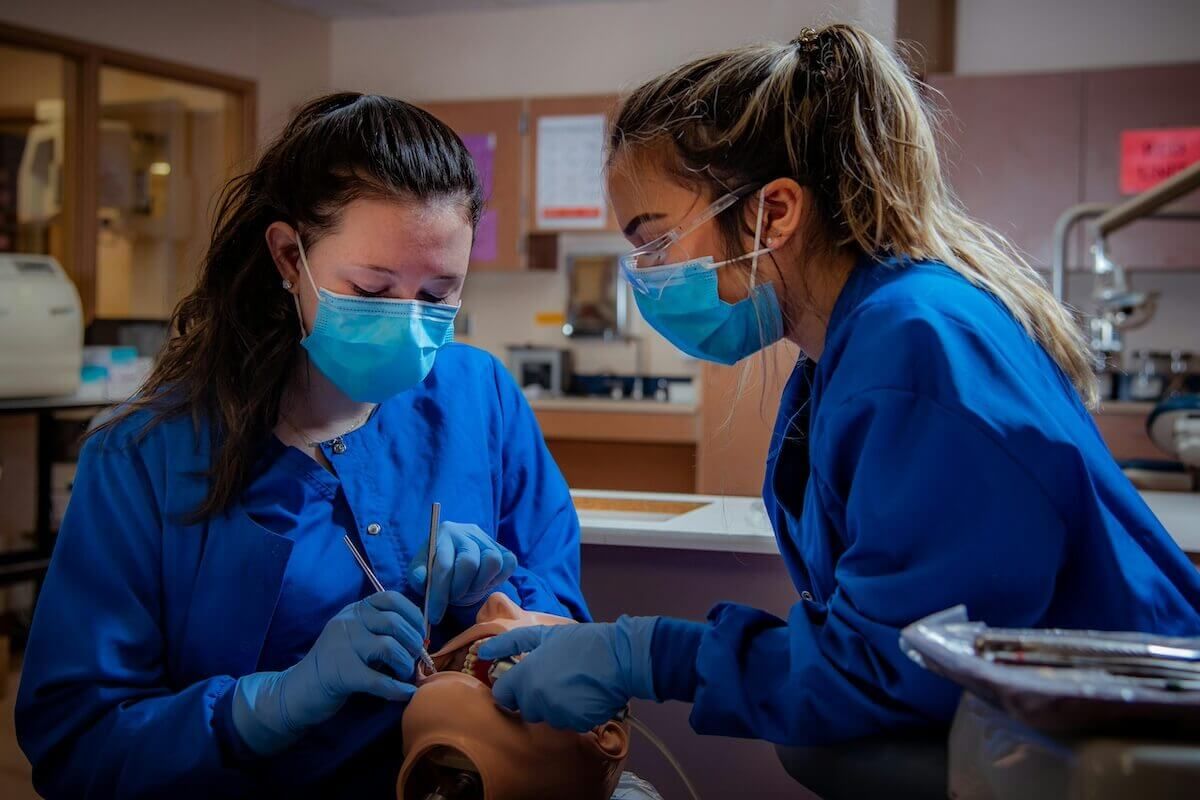Advertiser Disclosure
Last update: December 30, 2024
6 minutes read
Average Cost of Medical School 2024
Wondering how much medical school will cost you in 2024? Dive into the latest figures and tips to help you budget for your medical education journey.

By Brian Flaherty, B.A. Economics
Edited by Rachel Lauren, B.A. in Business and Political Economy
Learn more about our editorial standards



By Brian Flaherty, B.A. Economics
Edited by Rachel Lauren, B.A. in Business and Political Economy
Learn more about our editorial standards
Thinking about stepping into the world of medicine? Before you commit to years of rigorous study, it's essential to understand the financial landscape of medical school in 2024. After all, becoming a doctor isn't just a commitment of time and energy—it's a significant financial investment.
Although medical school can come with high upfront costs, doctors in the US also have high earning potential. But remember, being a doctor is more than just a job - it’s a calling to improve the lives of your patients and make a positive impact on the world. So, how much will medical school set you back, and what can you do to manage the costs?

Key takeaways
- Annual tuition averages are $34,550 for public in-state, $58,010 for out-of-state, and $58,000–$60,000 for private schools
- Total four-year costs range from $160,000 to $260,000, including fees and insurance
- Additional expenses like health insurance, living costs, application fees, and books add significantly to the overall cost
How much does medical school tuition cost annually in 2024?
Medical school tuition varies widely depending on the type of institution and whether you're an in-state or out-of-state student.
- Public medical schools (In-state residents): If you're attending a public medical school in your home state, you can expect to pay an average annual tuition of $34,550.
- Public medical schools (Out-of-state students): Out-of-state students face higher tuition, with averages around $58,010 per year.
- Private medical schools: Private institutions generally don't differentiate between in-state and out-of-state students. The average annual tuition here ranges from $58,000 to $60,000.
What is the total cost for four years of medical school?
When planning for medical school, it's crucial to consider the total cost beyond just tuition. Over four years, including fees and health insurance, here's what you might be looking at:
- In-state students at public schools: $159,620 total.
- Out-of-state students at public schools and private schools: $250,000-$260,000 total.
That's a hefty sum, isn't it? But don't let these numbers deter you just yet. On average, doctors in the US can earn more than $350K per year once their training is completed, which could make the tuition investment worth it.
What additional expenses should medical students budget for?
Beyond tuition and mandatory fees, several other expenses can add up:
- Health insurance and student fees: Approximately $5,000 to $7,000 per year.
- Living expenses: Housing, food, transportation, and personal expenses vary widely based on location but can significantly impact your overall budget.
- Application costs: Between $800 and $1,100. This includes MCAT fees, primary and secondary application fees, and interview travel expenses.
- Books and supplies: Typically $500 to $2,000 per year.
How have medical school costs changed over time?
You might be wondering if these costs are stable or if they're subject to change.
- Steady increase: Over the past decade, the cost of medical school has increased by roughly 25%.
- Annual rise: Since 2014, there's been an average annual increase of about 2.5% in medical school tuition and fees.

TuitionHero Tip
These trends highlight the importance of financial planning, as costs are likely to continue rising.
Are there special programs or financial aid options available?
Absolutely! While the costs may seem daunting, several programs aim to alleviate the financial burden:
- Tuition-free programs: Schools like the Kaiser Permanente Bernard J. Tyson School of Medicine and the Uniformed Services University of the Health Sciences F. Edward Hébert School of Medicine offer tuition-free education.
- Significantly reduced tuition: The New York University Grossman School of Medicine provides substantial tuition reductions.
- Scholarships and grants: About two-thirds of medical students receive some form of scholarship or grant aid.
Exploring these options can significantly reduce your out-of-pocket expenses.
How do costs vary by geographic location and institution?
Location and institutional choices can greatly impact your total cost:
- Affordable public schools: States like Texas boast some of the most affordable public medical schools due to state regulations capping tuition. Texas A&M University and UT Health Science Center at Houston are notable examples.
- Expensive private schools: Top-ranking private institutions like Harvard University, Midwestern University, and Columbia University can have annual tuition costs exceeding $70,000.
Considering both the cost and the quality of education is essential when choosing where to apply.
Compare private student loans now
TuitionHero simplifies your student loan decision, with multiple top loans side-by-side.
Compare Rates
What are some key figures and institutions to consider?
Here's a quick rundown of notable schools and their financial offerings:
- Kaiser Permanente Bernard J. Tyson School of Medicine: Offers a tuition-free program, potentially saving students over $200,000.
- Uniformed Services University of the Health Sciences F. Edward Hébert School of Medicine: Also tuition-free, with the added benefit of a salary and benefits in exchange for military service after graduation.
- New York University Grossman School of Medicine: Provides significantly reduced tuition to alleviate student debt.
- Harvard Medical School: One of the most prestigious and expensive, with a total estimated cost of around $420,000 for four years, including living expenses.
What do the numbers say?: A year-over-year comparison
Understanding the numbers can help you make informed decisions:
- Average annual increase: Medical school costs have been rising by about 2.5% each year since 2014.
- Total four-year cost range: Between $162,000 and $265,000, depending on the school and residency status.
- Average yearly cost: Approximately $59,000 per year, combining tuition and fees.
These figures emphasize the importance of early financial planning.

TuitionHero Tip
Did you know that some medical schools offer completely free tuition? Schools like the Kaiser Permanente Bernard J. Tyson School of Medicine are changing the game by eliminating tuition costs for certain cohorts, making medical education more accessible.
Dos and don'ts of planning for medical school
Do
Research financial aid
Consider cost of living
Budget for all expenses
Don't
Don't neglect hidden costs
Don't assume that more expensive means better

Why trust TuitionHero
TuitionHero supports your medical school journey by providing insights into managing costs, including tuition, fees, living expenses, and financial aid options. We help you explore strategies to make medical education more affordable and accessible.
Frequently asked questions (FAQ)
The average annual tuition for public medical schools is approximately $34,550 for in-state students and $58,010 for out-of-state students. Private medical schools typically range from $58,000 to $60,000 per year.
In-state public school students can expect a total cost of around $159,620, while out-of-state and private school students may see totals between $250,000 and $260,000, factoring in fees, health insurance, and living expenses.
Medical students should account for health insurance ($5,000-$7,000 per year), living expenses, application fees ($800-$1,100), and books and supplies ($500-$2,000 annually). Location can heavily impact living costs.
Medical school costs have risen by approximately 25% over the past decade, with an average annual increase of 2.5% since 2014. Proper financial planning is crucial as these costs continue to rise.
Yes, options include tuition-free programs at institutions like the Kaiser Permanente Bernard J. Tyson School of Medicine and the Uniformed Services University of the Health Sciences. About two-thirds of medical students receive scholarships or grant aid.
Final thoughts
Embarking on a medical career is both noble and challenging. While the costs can seem overwhelming, understanding them upfront and exploring all available financial aid options can make your dream more attainable. Remember, investing in your education is investing in your future.
Source
Author

Brian Flaherty
Brian is a graduate of the University of Virginia where he earned a B.A. in Economics. After graduation, Brian spent four years working at a wealth management firm advising high-net-worth investors and institutions. During his time there, he passed the rigorous Series 65 exam and rose to a high-level strategy position.
Editor

Rachel Lauren
Rachel Lauren is the co-founder and COO of Debbie, a tech startup that offers an app to help people pay off their credit card debt for good through rewards and behavioral psychology. She was previously a venture capital investor at BDMI, as well as an equity research analyst at Credit Suisse.
At TuitionHero, we're not just passionate about our work - we take immense pride in it. Our dedicated team of writers diligently follows strict editorial standards, ensuring that every piece of content we publish is accurate, current, and highly valuable. We don't just strive for quality; we aim for excellence.
Related posts
While you're at it, here are some other college finance-related blog posts you might be interested in.
Shop and compare student financing options - 100% free!

Always free, always fast
TuitionHero is 100% free to use. Here, you can instantly view and compare multiple top lenders side-by-side.

Won’t affect credit score
Don’t worry – checking your rates with TuitionHero never impacts your credit score!

Safe and secure
We take your information's security seriously. We apply industry best practices to ensure your data is safe.
Finished scrolling? Start saving & find your private student loan rate today





